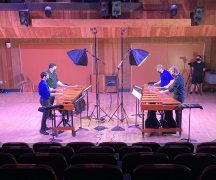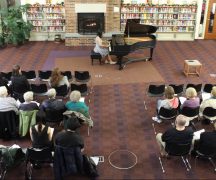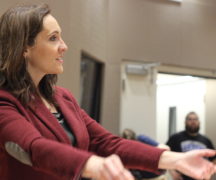By DAVID DUPONT
BG Independent News
Pianists at Bowling Green State University will perform the first concert in a festival honoring Russian composer and mystic Alexander Scriabin tonight. This year is the 150th anniversary of his birth.
Scriabin is noted for his dazzling compositions, especially for piano, as well as his exploration of mystical philosophies that weaves its way into the music.
“Innovation and Audacity: The Complete Piano Sonatas of Alexander Scriabin” consists of a set of two concerts during which all 10 of the piano sonatas published during the composer’s lifetime will be performed
Tonight (Tuesday, Jan. 11) and tomorrow (Wednesday, Jan. 12) at 8 each evening n Bryan Recital Hall, the pianists – the five piano faculty members and two doctoral students – will present the programs.
Then on Friday and Saturday (Jan. 14 and 15) they will travel to Ann Arbor to perform the two concerts at the Kerrytown Concert House also at 8 p.m.
The third venue will be the Toledo Museum of Art where the festival will be presented over two Sundays, Jan. 16 and Jan. 23 at 3 p.m. in the Great Gallery.
The BGSU and museum concerts are free. Tickets for the Kerrytown show are $10-$45. Click for tickets and free livestream.
The first concert features Sonatas 1,4, 6, 7, and 10 performed by Sandra Coursey, Laura Melton, Cole Burger, Robert Satterlee, and Yevgeny Yontov. The second concert features Sonatas Numbers 2, 3, 5, 8 and 9 performed by Solungga Liu, Melton, Humay Gasimzade, Yontov, and Satterlee.
The festival evolved through informal conversations among the faculty about how to mark the anniversary of Scriabin’s birth. The faculty all has an interest in his work so they settled on the festival showcasing the sonatas. Sharing the performances among the faculty and the two doctoral students, Coursey and Gasimzade, made it possible. For one pianist to do all 10 would be an arduous undertaking, Satterlee said.
“He’s a really unusual figure,” Satterlee said. “He had very unusual ideas about philosophy and his place in the world and the meaning of music.” This was reenforced by the fact that according to the old Gregorian calendar he was born on Christmas Day and died on Easter.
Scriabin started out writing works inspired by Frederic Chopin, but as he started to immerse himself in various mystical ideas, Satterlee said, “his compositional style became really extraordinary, very fanciful and the harmonies were truly unusual.”
Satterlee continued: “All the extramusical stuff aside, the music itself is really beautifully written for the piano, full of poetry, lots of variety of moods. He creates a sound world in each piece that’s very compelling. All the stuff about his life and philosophical ideas, that’s just icing on the cake.”
Despite the strange harmonies and textures, Scriabin is still rooted in the piano style of the 19th century. “They’re so well laid out for the piano from a technical point of view,” he said. But because of the sheer number of notes, shifts in textures, and dense harmonies, “it takes a lot of practice to figure out what’s on the page.”
Pianists must also be attuned to the emotional content in the music because the moods change so quickly.
Scriabin also had synesthesia, so he associated different notes and harmonies with different colors. Some pieces have color guides, and in his time, he experimented with projecting these colors as he played, a precursor of the light show.
Satterlee said the BGSU performers opted not to present the sonatas chronologically. Because Scriabin’s style changed so radically from 1892 to 1913, the performers wanted each recital to offer a variety of his work.





